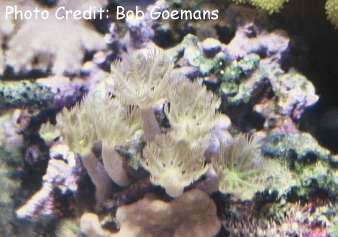
By Bob Goemans

Likely Reef Tank Suitable
Likely Fish-Only Tank Suitable
Range: Indo-Pacific Ocean: Widely distributed.
Natural Environment: Found along upper reef slopes and upper hardpan areas of lagoons.
General Husbandry: Specimens should be placed in aquarium upper areas along well-lit rocky structures where they should be secured/glued, so they do not fall into darker areas of the aquarium. Soon, will then send out runners that will stick to hard surfaces, which will also help secure the main specimen, and develop into new polyps.
Somewhat similar in 'growth,' to Pachyclavularia violacea/viridis (Green star Polyps) i.e., an encrusting species, however, it expands via a creeping mat-like growth.
Generally very hardy and prefers moderate to strong light and gentle water flow.
Taxonomy:
Kingdom: Animalia
Phylum: Cnidaria
Class: Anthozoa
Subclass: Octocorallia
Order: Alcyonacea
Family: Clavulariidae
Genus: Clavularia
FYI: Seems to do better when alkalinity is maintained above 3.0 mq/l.
Experience Level: Beginner
Diet: Photosynthetic
Temperament: Peaceful
Aquarium Environment: Reef or fish-only aquarium
Coral Safe:Yes
Fish Safe: Yes
Invertebrate Safe: Yes
Acclimation Time: 30 minutes+
Aquarium Hardiness: Hardy
Calcium (Ca): 380 - 430 mg/l
Alkalinity: 2.5 - 3.0 meq/l
Phosphate (PO4): <0.05 mg/l
Magnesium (Mg): approx. 1350 mg/l (relate to specific gravity)
Strontium (Sr) 8 - 10 mg/l
Temperature Range: 72 - 83°F (22 - 28°C)
Minimum Tank Size: 10 gallons
Lighting: PAR 300 - 450
Water Movement: WM 1 - 2
Specific Gravity: 1.023 - 1.025
pH: 8.0 - 8.4
Iodine/Trace Elements Monitor/as necessary to maintain quality seawater.
